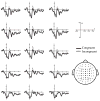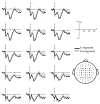Skilled readers begin processing sub-phonemic features by 80 ms during visual word recognition: evidence from ERPs
- PMID: 18456383
- PMCID: PMC2677072
- DOI: 10.1016/j.biopsycho.2008.03.009
Skilled readers begin processing sub-phonemic features by 80 ms during visual word recognition: evidence from ERPs
Abstract
Two masked priming experiments investigated the time-course of the activation of sub-phonemic information during visual word recognition. EEG was recorded as participants read targets with voiced and unvoiced final consonants (e.g., fad and fat), preceded by nonword primes that were incongruent or congruent in voicing and vowel duration (e.g., fap or faz). Experiment 1 used a long duration mask (100 ms) between prime and target, whereas Experiment 2 used a short mask (22 ms). Phonological feature congruency began modulating the amplitude of brain potentials by 80 ms; the feature incongruent condition evoked greater negativity than the feature congruent condition in both experiments. The early onset of the congruency effect indicates that skilled readers initially activate sub-phonemic feature information during word identification. Congruency effects also appeared in the middle and late periods of word recognition, suggesting that readers use phonological representations in multiple aspects of visual word recognition.
Figures








References
-
- Abramson M, Goldinger S. What the reader’s eye tells the mind’s ear: Silent reading activates inner speech. Perception and Psychophysics. 1997;59:1059–1068. - PubMed
-
- Adams MJ. Beginning to Read: Thinking and learning about print. MIT Press; Cambridge, MA: 1990.
-
- Ashby J. Prosody in silent skilled reading: Evidence from eye movements. Journal of Research in Reading, Special Issue: Prosodic Sensitivity in Reading Development. 2006;29:318–333.
-
- Ashby J, Martin AE. Prosodic phonological representations early in visual word recognition. Journal of Experimental Psychology: Human Perception and Performance. 2008;34:224–236. - PubMed
Publication types
MeSH terms
Grants and funding
LinkOut - more resources
Full Text Sources
Miscellaneous

